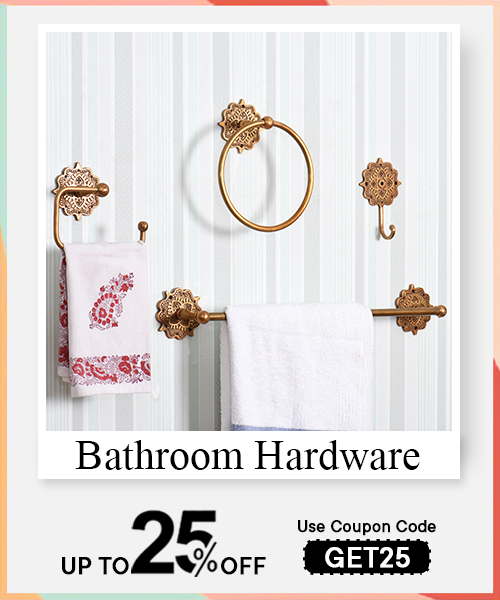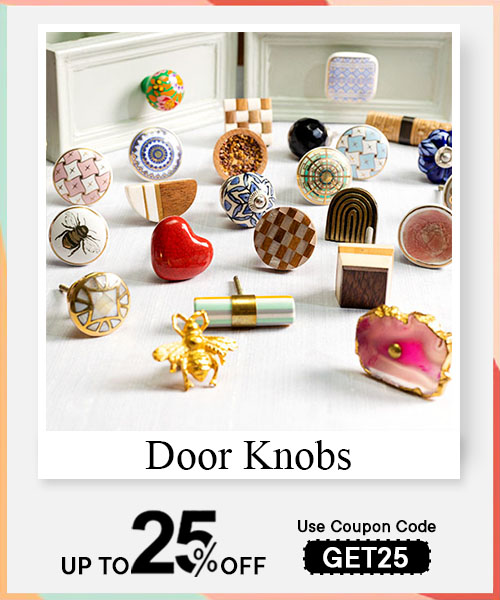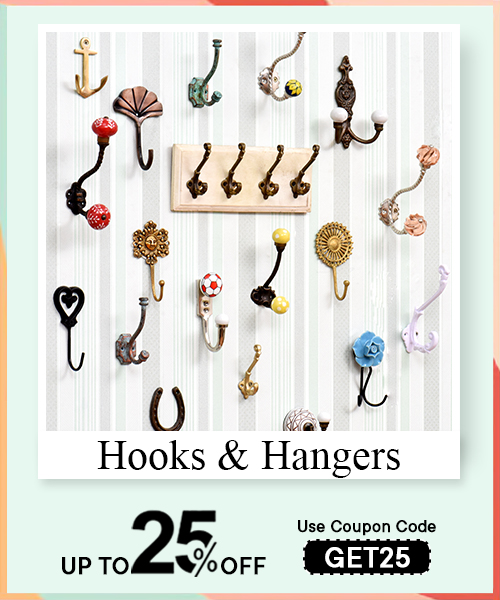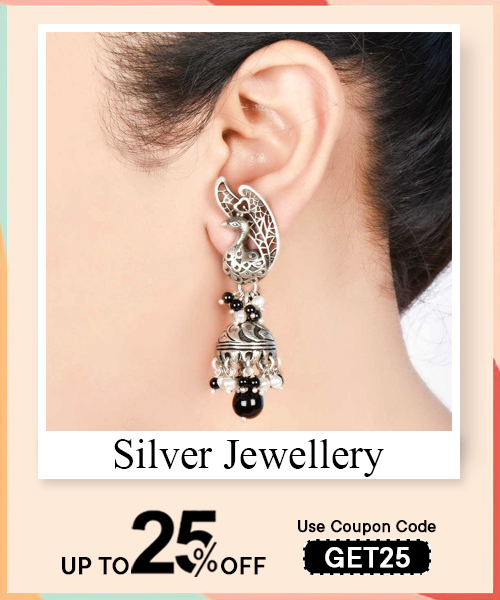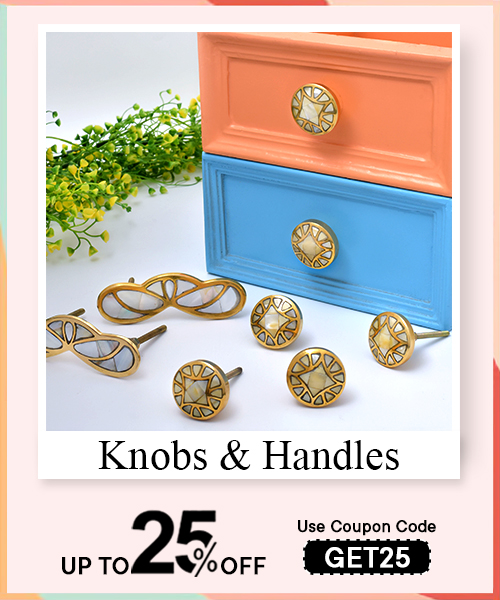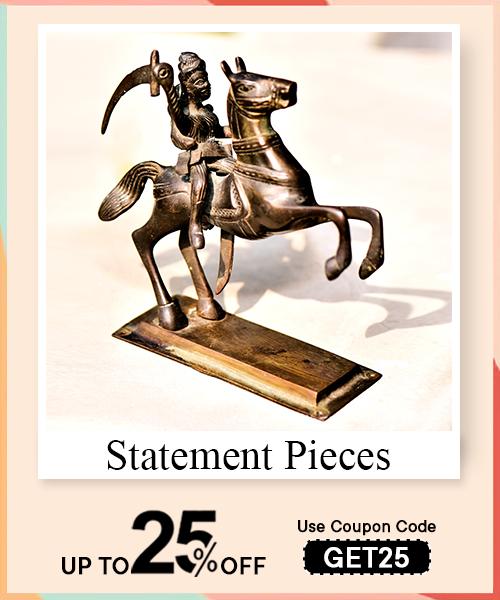The rich culture and traditions of India are well-recognized by people worldwide. Its traditions, rituals, beliefs, and artistic expressions have greatly enhanced beauty and history. Indian art genres include handwoven silks, textiles, pottery, sculpture, painting, and many more.
Products manufactured by hand have value and fascinating designs with minute details. The talented craftspeople in India take great pleasure in using age-old methods and are passionate about maintaining authenticity. People who appreciate the raw beauty of handmade goods and promote handicrafts as a means of conserving tradition may be found in India. They are ready to master the skills themselves and actively engage in trades and fairs held worldwide.
Dhokra Art is one of the ancient, traditional art forms that originated in Bastar, a district in Chattisgarh, India's southern region. The lost-wax casting method is used in dhokra art to create beautiful items like wall hangings. This exquisite art celebrates the beauty of tribal cultures, the lives of content farmers, gods, goddesses, animals, legendary beings, and more. Non-ferrous metal art is celebrated, and this method is well-known in India and other areas of the world.
1. Trailing Dhokra Art History
Dhokra Art is made from a historic metal casting technique called lost wax casting. The technique was used thousands of years back to cast non-ferrous metals like copper to make artifacts. Some old artisans also used alloys like brass or bronze. Brass is a mixture of zinc and copper, while bronze is an alloy of tin and copper. About the artisans
The name of this unusual and attractive artform is named after 'Dhokar Damar,' a nomadic Indian tribe belonging to the eastern part of the country. The tribe initially resided in the Bankura-Dariapur belt in West Bengal, parts of Madhya Pradesh, and Odisha. Historians believe that the custodian of this legacy is mainly the tribal communities living in this region and famously known as Dhokra art of West Bengal.
Interestingly, this prized Indian art is not limited to only one region of the country. It is believed that the artisans might have traveled from one part to the other and carried with them the knowledge and skills of Dhokra and passed it from one generation to the other.
As a result, the tribal community that was primarily into making Dhokra Art and lived in the region covering Birbhum, Purulia, Burdwan, and Midnapore is now spread to the neighboring regions too, having evolved this legacy to include local aspects and interpretations.
Today the tribe lives across the entire eastern belt of India, stretching from Jharkhand to Chattisgarh to Telangana to West Bengal and Odisha. There are reasons to believe that some of the oldest tribes in India, like the Gonds in Madhya Pradesh and Bhils occupying regions like Rajasthan, Western Maharashtra, western Madhya Pradesh, and southeastern Gujarat, have been practicing this folk art for ages. The art form is also, therefore, popularly known as Dhokra art of Jharkhand and Dhokra art of Chattisgarh.
Another region that is known for its rich contribution to this art is Bastar in Chattisgarh. In fact, the Bastar Dhokra Art has its own name and claim to fame, not just in the domestic market but internationally too. The ethnic designs of this art were earlier available only in the local weekly markets in the region.
However, ever since the online medium has evolved, it has opened the doors of opportunities for the tribal people to preserve their valuable legacy. Today, buyers from India and worldwide can buy Dhokra Art online from respected and reputed online stores. As vivid as the artform is, similarly, different renditions and interpretations curated by the tribal people settled in the central and eastern parts of the country.
2. The process of making Dhokra art
The tribals make this folk art using the ancient methods and techniques they have learned from their ancestors. Dating back to the Age of Metallurgy, the process typically involves extracting metal from minerals, almost the way it was done about 4,000 years back.
The technique is based on annealing, where the metal extract is heated to reach extremely high temperatures to melt. It is then filled in the pre-casted molds, where the metal is allowed to cool and take the shape of the mold. The mold preparation involves great work of artistry and is not as easy as it may sound, or pieces of the art may appear.
The technique itself has undergone a tremendous transformation from the primitive age to the medieval era. Originally, the clay model or the mold was made of wax, but later it got replaced with metallic ores and alloys, basically bronze and brass.
There are two kinds of processes used for making the cast – hollow casting, which is the conventional method, and solid casting, which is the modern interpretation. While the former method is mostly used in the central and eastern parts of the country, the latter is used primarily in the southern parts of India, like Telangana.
The process involves creating a core clay model first. The materials used for making the model are usually riverbed clay. Sometimes the model is made from the local soil that is mixed with rice husk and coal dust. Once the clay model is made, a mixture made from beehive wad, a resin derived from trees like Dammar gum tree, and melted tar is inserted in the discs in the shape of strings that are made manually.
Decorations, too, are made on the Dhokra piece by hand. Originally, beehive wax was used; today, candle and paraffin wax are also used. Another change is that some artisans do not make the strings manually anymore; they use a metallic and wooden press to do so.
In the solid casting method, instead of the clay core, a solid wax core is made. There is a funnel on the top of the wax or clay core with an opening through which scrap metal pieces are inserted.
These pieces are then melted through a firing process inside the mold. The process is called annealing. In the hollow-casting model, the clay cast is covered with jute, sand, and soil and dried in the Sun. When the metal cools down, the cast is removed, and through a demoulding process, the metal dhokra handicrafts are obtained.
One look at the artifacts and would get you nostalgic about the primitive era when hunting was the main occupation of mankind. The common themes of Dhokra art revolve around Hindu gods and goddesses, figurines of men, women, and children. The other common theme is different animals, ranging from horses to elephants and tortoise to owls.
All of these creatures have some or the other meaning or significance in Hindu mythology. For example, the owl denotes prosperity and death, while the elephant denotes wisdom. The horse represents movement, and the tortoise is usually representative of the feminine gender.
You would find all of these creatures deeply ingrained in the Hindu religion, with each having iconic roles to play in the evolution of the religion. For example, the tortoise is considered an incarnation of Lord Vishnu and denotes that it carries the seas and the lands on its back.
Over a period, artisans have tried to teach other forms from their daily lives to create dhokra wall arts. They have included holy lamps, caskets, utensils, and bowls in the gamut of Dhokra art.
4. Dhokra art of West Bengal
This artwork is mentioned in the book 'Crafts of West Bengal' by author Prabhas Sen, published in 1994. The author mentions how the Dhokra art form spread across the entire south and western parts of modern Bengal. The rural district of Bikna is one of the thriving hubs for Dhokra art. The local artisans are called Mal or Malars, or Karmakars.
The natives initially would repair broken utensils using this art form while also selling their primitively made Dhokra statute of Lordess Lakshmi mounted on her own. During those prehistoric times, transactions were all based on the barter system, and the artisans would get food grains in exchange for these idols.
Most of the idols revolved around holy statues of gods and goddesses like Lakshmi, Radha Krishna, and more. There was also this belief that the Dhokra idols brought in good fortune and prosperity and was markedly a gift for the newlyweds in this region.
As per historians, Dhokra artisans in the Dariyapur in the East Bardhaman district have been practicing this art form for more than a century. The Dariapur Artisans Cooperative in this district work with brass primarily. Dhokra art from West Bengal is characterized by the adornment of sculpted figurines with thin and twisted brass wires. This art form is now used for making Dhokra jewelry too.
The art from West Bengal has received much attention and love from people worldwide because of the characteristic rustic appearance backed by a primitive minimalist look. The thin-wired adornments and the folk motifs add charm to the artistry.
Some of the popular items showcased from Dhokra art of West Bengal include the Bankura elephants and horses and Krishnanagar Clay Dolls. However, many from the artisan class struggle to survive here in the face of stiff competition from modern-day mass-produced home décor items characterizing the capitalist market spirit.
The interesting story about the evolution of the Bankura horse goes as the potters residing in Panchmura worked on creating the terracotta Bankura horse. Historians have reasons to believe that the horse was worshipped as a deity representing the Sun. You can easily find a terracotta representation of the Bankura horse with its characteristic long ears and symmetrical body and elaborately adorned online.
Not just that, their counterparts in the Kandhamal district in Odisha use Dhokra Art to make a representation of Lord Jagannatha. If you follow Indian holy scripts, you would know that the Lord wears a characteristic nose ring, and Dhokra artisans from this district ensure that they decorate the idol of the Lord with the nose ring, jewelry, crown, and other embellishments. Dhenkanal in Odisha also has tribals working on this folk art. They make figures of gods and goddesses like Durga, Ganesha, Shiva, and Saraswati. They also make daily use of glasses, anklets, jewelry, soap holders, statutes of tribal men and women, and more.
5. Dhokra art of Jharkhand
Parts of Jharkand also have local tribal craftsmen who practice the art of making Dhokra items. Like other parts of India, these indigenous tribes pass on the creative know-how from one generation to another. The people who create Dhokra art in Jharkhand are called Malhar or Malhore tribes. The characteristic feature is the intricate detailing and bird motifs on the art form.
Some of the popular representations include the idols of deities like Durga and Ganesha. Also, the tribals make jewelry pieces, small containers, utensils, vessels, and miniature figurines. Art lovers can identify immediately that the art belongs to Jharkhand by exploring the intricate and elaborate work on the pieces. You will find many daily-use items like key chains, votive figures, and locals riding horses, elephants, and more. Dhokra art of Chattisgarh
Bastar lies in the southern parts of Chattisgarh and is very famous for brass work and bell metal artwork. It is the Ghadwa tribe residing here that is experts in Dhokra Art of Chattisgarh.
The local story goes that the king of Bastar, Bhan Chand, had once received a piece of Dhokra necklace as a gift from an artisan. The charming piece attracted the king's attention. He rewarded the artisan and conferred the title 'Ghadwa'; he also popularized the art form in his community. Since then, Bastar has been at the centre of Dhokra Art. Bastar Dhokra Art.
Like the other regional interpretations, the Bastar artwork is also metallurgically based on the lost wax method. The tribal communities of Bastar make these handicrafts with ancestral tools and not any other kind of modern-day machinery. Therefore, there is a unique nostalgic feel to the entire artwork, especially if one sees the artisans making these artworks.
The Bastar form is limited to the metal form; there are bamboo and woodwork and even soil work options for Dhokra art. Bamboo art is used mainly for making items like chairs, baskets, home décor items, mats, furniture pieces, etc., and is generally made from bamboo sheets. In most cases, you would find such items in households nearby and across the world as these are everyday-use items.
The woodwork is done on wood where the tribal people make images of gods and goddesses and animals. It is noteworthy that each piece of art is distinct and depicts the innate creativity of the artisan.
The soil art of Bastar is unique because such artworks are very difficult to find in today's world. The truth of the story is that there are very few patrons of this kind of artwork; as a result, it is a dying art form that needs revival. Tribals make statues of gods and goddesses, pots, flower vases, home décor items, furnishings, utensils, etc., with soil. The metal art from Bastar is made from copper alloys, especially bronze. The items that are made include gods and goddesses, décor items, etc.
It is interesting to note that Bastar is mostly covered with thick forests, and the Dhokra Art being an ancestral artwork passed onto the residents by their forefathers, is eco-friendly, besides reflecting the community's talent.
Art lovers and connoisseurs can now buy artworks from various handicraft fairs, where the community is encouraged to participate and showcase their talent by the state and central handicraft ministries. Also, art enthusiasts can shop in the virtual world without needing to step out of the home during the prevailing challenging times to shop for Dhokra Art online.
The most popular art item from Bastar is the Dhokra Bull that can be purchased online from a reliable handicrafts store.
6. Dhokra Art online – options galore
The best of this ancient folk art can now be found online. Replicated by tribal artisans, a spectrum of Dhokra Art online awaits you that is an art lover's must-have in his collection.
From Dhokra art wall décor items to a brass elongated tribal lady, golden brass Dhokra Tribal figures, handcrafted brass art from Bastar, brass door musician handle, handmade brass wall art décor items in round and rectangle sitting bull, various figurines, shapes, and figures, elephant, fish, tribal pig, tribal stars, tribal couple, and more.
The best online handicrafts stores will offer you a comprehensive range to buy from at various price ranges. If you are looking for the perfect e-store to decorate the corner of the art in your home with the traditional folk art called Dhokra Art, you can visit https://www.indianshelf.in/ for an awesome shopping experience.
Summarizing
Dhokra Art is a part of our cultural heritage. While it is an individual choice to encourage local and folk art, it is important to understand that our rich past is our legacy and should not fade away or die down. There are tribals in Indian villages that spend all their waking hours creating unique handicrafts using their hands, doing their best to keep the ancient art alive.
The governments are doing their bit; we can do the rest. These art forms look amazing pieces as home décor items and can adorn your home wonderfully well. Bring home a handmade piece of Dhokra art to help a tribal family in its endeavor to maintain the essence of the artwork.


















